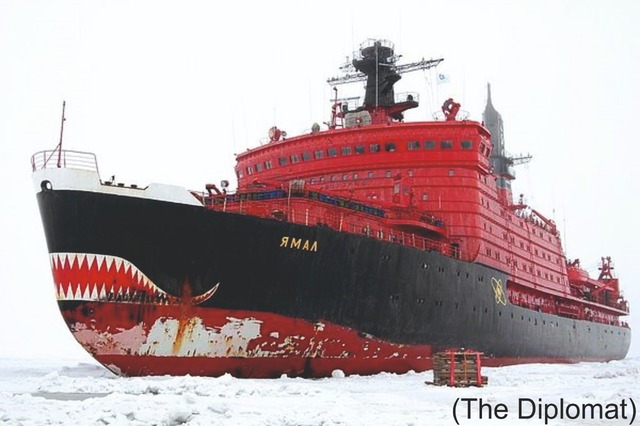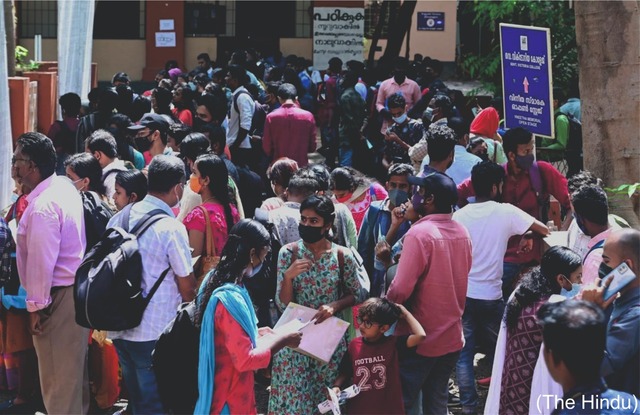Russia nuclear icebreakers and militarisation of the Arctic (GS Paper 2, International Relation)

Why in news?
- Recently, the Russian President virtually presided over the launch and flag raising ceremony of two nuclear-powered icebreakers at St. Petersburg and said such icebreakers were of “strategic importance”.
- As climate change opens up the Arctic giving access to new routes and resources, there is a race by adjoining countries to build up their militaries and Russia has a clear lead over them.
Details:
- Both icebreakers were laid down as part of Russia’s large-scale, systematic work to re-equip and replenish the domestic icebreaker fleet, to strengthen Russia’s status as a “great Arctic power.”
- The 173.3-metre-long ‘Yakutia’, with a displacement of up to 33,540 tonnes, was launched into water and can break through three metres of ice.
- The flag was raised on another vessel Ural, which is expected to become operational in December, while the Yakutia will join service by end-2024.
- There are two already similar vessels in service, Arktika and Sibir.
- A much more powerful 209-metre-long nuclear icebreaker “Rossiya,” displacing up to 71,380 tonnes, would be completed by 2027.
Why are the Russian icebreakers significant?
- The Northern Sea Route cuts down time to reach Asia by up to two weeks compared to the current route via the Suez canal. In line with this, the updated Russian naval doctrine, unveiled in July, envisages “diversifying and stepping up naval activities on the Spitsbergen, Franz Josef Land and Novaya Zemlya archipelagos and Wrangel Island.”
- They are needed for the study and development of the Arctic, to ensure safe, sustainable navigation in this region, to increase traffic along the Northern Sea Route.
- The development of this most important transport corridor will allow Russia to more fully unlock its export potential and establish efficient logistics routes, including to South East Asia.
Why are countries racing towards the Arctic?
- There has been a race among Arctic states and near-Arctic states to augment their capabilities in a bid to be ready to capitalise on the melting Arctic.
- Russian military modernisation in the Arctic has prompted other Arctic states to join the bandwagon. Unlike Antarctica, the Arctic is not a global common accentuating the problem.
- For instance, the North Atlantic Treaty Organisation (NATO) has been conducting regular exercises in the region while partner countries are investing in upgrading military capabilities.
- At the same time, China, which calls itself to be a near-Arctic state, has also announced ambitious plans for a ‘polar silk route’ to connect to Europe as well building massive icebreakers.
Where does India stand with respect to the Arctic?
- strengthening India’s scientific research and cooperation,
- climate and environmental protection,
- economic and human development,
- transportation and connectivity,
- governance and international cooperation, and
- national capacity building in the Arctic region.
- India is also one of the 13 Observers in the Arctic Council, the leading intergovernmental forum promoting cooperation in the Arctic.
Way Forward:
- As the earth further heats up, which is more profound at the poles, the race for the Arctic is set to accelerate which makes the Arctic the next geopolitical hotspot with all interests converging on it – environmental, economic, political and military.
Aviation Ministry notifies draft Aircraft Security Rules, 2022
(GS Paper 2, Governance)
Why in news?
- Recently, the Civil Aviation Ministry has notified the draft Aircraft Security Rules, 2022.
- It will enable the Bureau of Civil Aviation Security (BCAS), to impose penalties up to ₹1 crore on airports and airlines for violation of security measures.

Background:
- The amendment in Parliament was required after the United Nation’s aviation watchdog, International Civil Aviation Organisation, raised questions about the three regulators functioning without statutory powers.
Key Highlights:
- The rules will supersede Aircraft Security Rules, 2011 and were necessary after Parliament passed the Aircraft Amendment Act, 2020, giving statutory powers to the BCAS, along with the Director-General of Civil Aviation and Aircraft Accident Investigation Bureau.
- These allow them to impose penalties which could only be imposed by courts earlier.
- The Act also raised the maximum penalty from ₹10 lakh to ₹1 crore.
Penalty:
- Once the draft Rules are finalised, the BCAS can impose a fine of ₹50 lakh to ₹1 crore on airports and airlines if they fail to prepare and implement a security programme, or if they commence operations without seeking a security clearance.
- Large airports can also face a penalty of ₹1 crore if they fail to plan the design and layout of the airport in accordance with the National Civil Aviation Security Programme.
- Individuals will also face penalties ranging from ₹1 lakh to ₹25 lakh depending on the nature of the offence.
- According to the proposed rules, the BCAS will also be able to suspend or cancel an entity’s airport security clearance and security programme.
Way Forward:
- Once the Aircraft Security Rules, 2022 are finalised, they will go a long way in ensuring an effective aviation security apparatus in the country.
Unemployment rate dips marginally to 7.2% in July-September 2022
(GS Paper 3, Economy)
Why in news?
- Recently, the latest Periodic Labour Force Survey (PLFS) was released by the National Statistical Office (NSO).

Unemployment ratio:
- The unemployment rate in urban areas for persons aged above 15 eased to 7.2% in July-September 2022 from 9.8% a year ago and 7.6% in the previous quarter.
- The unemployment rate was 6.6% for men and 9.4% for women. It was 9.3% and 11.6%, respectively, in July-September 2021.
Worker-population ratio (WPR):
- The WPR also witnessed a marginal increase compared with last year’s. The WPR is defined as the percentage of employed persons in the population.
- The WPR in urban areas for persons aged 15 and above stood at 44.5% in July-September 2022, an increase from 42.3% in the corresponding period in 2021. It was 43.9% in April-June 2022.
- The WPR among men was 68.6% and 19.7% among women. It was 66.6% and 17.6%, respectively, in 2021.
Labour force participation rate (LFPR):
- The labour force participation rate (LFPR) in urban areas for persons aged 15 and above, increased to 47.9% in July-September 2022, from 46.9% in the corresponding period in 2021.
- It was 47.5% in April-June 2022.
- The LFPR among men was 73.4% and 21.7% among women. In 2021, it was 73.5% and 19.9%, respectively.
LFPR of women:
- Ashoka University’s Centre for Economic Data and Analysis (CEDA) Recently launched an initiative to address the country’s plunging women LFPR.
- The CEDA said in a release that over the past two decades, the LFPR of women has been steadily declining, despite an increase in their educational attainment.



